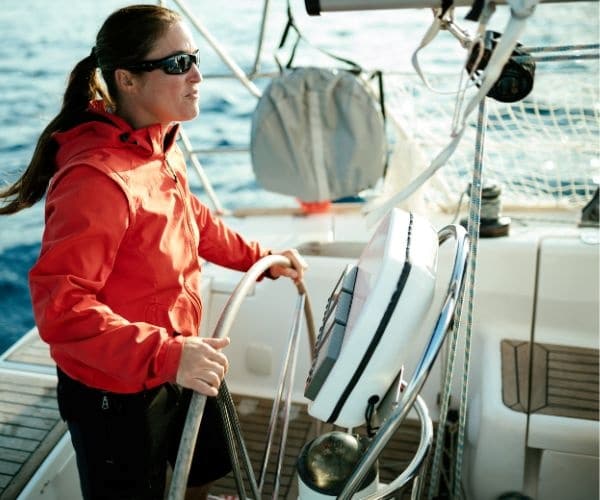The joy of sailing lies in the sense of freedom and connection with nature, but it also brings with it important responsibilities – especially when the weather takes a turn for the worse.
No matter your experience level, the sea can be unpredictable. Even with careful attention to forecasts, unexpected weather changes can still catch sailors off guard. For seasoned sailors, the challenge is about staying vigilant and prepared. For newcomers, rough conditions might not be part of your plans, but having some knowledge can make all the difference if the weather shifts unexpectedly.
Read on and we’ll share key tips to help you prepare for and navigate heavy weather sailing more safely, drawing on trusted advice from the coastguard, sailing clubs, and experienced mariners. Whether you’re cruising along the coast or venturing further afield, a little preparation goes a long way.
Monitoring and interpreting weather forecasts

Before you cast off, always check a reliable marine weather forecast. Unlike land-based forecasts, marine reports give detailed information about wind speeds, gusts, sea state, and visibility.
Trustworthy sources include:
The Met Office’s Inshore and Shipping Forecasts
Windy and PredictWind apps
Navtex and VHF weather broadcasts
Learn to interpret terms such as:
“Gale warning” (34-40 knots)
“Severe gale” (41-47 knots)
“Rough seas” (2.5–4m waves)
Seasonality matters too. Winter storms and summer squalls can both be fierce but behave differently. The UK sees more persistent and stronger winds in winter, while summer storms are often fast-developing and localised.
Official Guidance: What authorities advise

When it comes to preparing for rough weather, it’s always worth tuning in to what the professionals have to say. Both the coastguard and your local sailing club can offer sailing in bad weather advice that could save you a world of trouble when conditions get tough.
Coastguard Advice
The coastguard isn’t just there for emergencies – they’re also a vital source of practical, proactive advice. Here are a few friendly reminders drawn from their guidance:
Plan ahead and share your intentions: Let someone ashore know where you’re heading, what time you expect to return, and who is onboard. A simple passage plan can make all the difference if something goes awry.
Keep an ear on Channel 16: The VHF radio is your best friend at sea. Channel 16 is the emergency and calling channel, but it’s also used for important weather updates and alerts. Even if you’re not expecting bad weather, it’s wise to listen in.
Know your limits – and your boat’s: Rough seas have a way of revealing weaknesses, both in vessels and in planning. Make sure the conditions match your experience and your boat’s capabilities.
In case of emergency: Don’t hesitate to call for help. Use VHF Channel 16 to call the coastguard, or if you’re near shore, dial 999 and ask for the coastguard. They’re there to help – no judgement, just support.
Sailing Club Recommendations
Your local sailing club isn’t just a place to grab a post-sail pint – it’s a goldmine of local knowledge. The seasoned sailors around you often know how local conditions behave better than any app can predict.
Stay in the loop: Many clubs now use WhatsApp groups or email lists to issue alerts when rough weather is expected. These quick updates can help you plan ahead or reconsider that afternoon sail.
Local tips for staying safe: Clubs often know the best mooring spots for various wind directions or tide states, and where to find reliable shelter when needed.
Listen to advice: If the old hands at your club are suggesting staying ashore, there’s probably a good reason. Taking on rough weather is not a badge of honour – it’s a calculated decision.
By keeping connected and tuned in to this kind of advice, you can make smarter, safer decisions before setting sail.
Recognising flags, signals, and warnings

Understanding visual signals around ports and harbours is an essential part of making safe decisions at sea. In the UK, many marinas and coastal areas use a combination of traditional maritime signals and modern communication tools to indicate current or forecasted conditions.
Common weather warning signals
Red Flag: Often used to indicate dangerous conditions or that the harbour is closed to small craft. Treat it as a serious warning not to venture out.
Storm Cones: A single cone with the point up signals a gale (Force 8 or more). Two cones (one up, one down) indicate a severe gale or storm force wind (Force 10+).
Ball-Diamond-Ball: This internationally recognised shape combination indicates a vessel is restricted in its ability to manoeuvre – not weather-specific, but important in poor visibility or heavy seas.
Where to Look
Harbour Master’s Office: Often displays flag signals and posts updates on a noticeboard.
Marina Masts or Poles: Signal flags are commonly flown on dedicated poles.
Local Coast watch Stations: Many display real-time weather warnings and visibility updates.
VHF Marine Radio: Listen to Maritime Safety Information broadcasts (typically Channel 16 or 67 in the UK) for weather updates, warnings, and other critical messages.
Know your vessel: Boat type matters

Every type of sailing boat responds differently in rough weather, so it’s important to understand how your vessel is likely to behave. Keelboats, for example, offer good overall stability, but if not properly reefed, they can become difficult to handle in strong winds. Dinghies, being lightweight and low to the water, are particularly vulnerable and are best kept ashore when rough weather is on the cards. Catamarans tend to provide excellent initial stability but can be prone to capsizing in sudden, strong gusts.
It’s a good idea to match your sailing plans to what your boat is actually built for. Consider factors like how high the freeboard is (how much of the hull sits above the water), whether the cockpit drains effectively, and the overall strength of the hull construction. When the sea turns nasty, these features can make all the difference. The golden rule? Don’t ask more of your boat than it’s designed to give.
Condition check: Boat & Equipment Prep

Hull & Rigging
Check for cracks, wear, or fatigue in the hull, rigging, and fittings.
Inspect sails and reefing systems.
Lubricate winches and check lines for chafe.
Navigation Systems
Ensure GPS, AIS, radar, and depth sounders are operational.
Carry paper charts and a compass as backups.
Safety Equipment
Inspect lifejackets and ensure they auto-inflate correctly.
Test EPIRBs and PLBs.
Check expiry dates on flares and first aid supplies.
General Gear
Pump the bilges and test automatic pumps.
Carry a toolkit, spare parts, and fuel.
Secure all loose items to avoid injury and damage.
Preparing the crew
When the sea gets bumpy, the confidence and coordination of your crew can be your greatest asset. A well-prepared crew is essential in rough weather:
- Conduct a safety briefing before departure.
- Assign specific roles for emergencies (man overboard, radio use, helm).
- Practise reefing, heaving-to, and storm tactics in calmer weather.
Encourage open communication – if someone feels unsure, listen and act accordingly.
Clothing and personal gear
Staying warm, dry, and visible isn’t just about comfort—it’s about safety. Dress for immersion, not the forecast:
Layer up with moisture-wicking base layers, fleece mid-layers, and waterproof outers.
Wear high-visibility foul weather gear.
Gloves, non-slip boots, and a warm hat are essential.
Carry a dry bag with spare clothes, snacks, and medications.
Each crew member should wear a lifejacket and carry a whistle and a light.
Sailing techniques in rough conditions
If you do find yourself sailing in rough weather, these are some steps to follow, recommended by more experienced sailors:
Reef early – It’s safer to reduce sail before you’re overpowered.
Balance the helm – use sail trim to reduce weather helm.
Steer carefully – avoid broaching by keeping the boat at a steady angle to waves.
Use drogues or sea anchors in extreme conditions to maintain stability.
Heave-to when necessary – It gives you time to assess the situation.
Safety tips for heavy weather sailing
Staying safe in rough conditions isn’t just about handling the boat, it’s also about staying calm, alert, and ahead of potential problems. Simple precautions and good habits can go a long way toward avoiding emergencies.
Always wear a safety tether and clip onto jacklines when on deck. This one small action could save your life if you’re knocked overboard by a rogue wave or sudden movement. Keep the cockpit clear of unnecessary gear and ensure hatches are closed and secured to prevent water ingress.
If you’re venturing offshore or into exposed waters, try to maintain regular position reports with someone ashore. Even a simple text or radio call can provide peace of mind and a record of your last known location.
Don’t forget about physical wellbeing. Stay hydrated, eat regularly, and rest when you can, fatigue and dehydration can lead to poor decisions and slower reactions just when you need to be sharpest. And most importantly, trust your instincts. If something doesn’t feel quite right, don’t push through it – pause, reassess, and make the safer call.
When not to sail - Knowing your limits
Sometimes the safest and most responsible choice is to delay your trip:
If the wind exceeds your experience level.
If your crew is inexperienced or uncomfortable.
If there’s a mechanical or structural concern.
Making a conservative decision is a hallmark of good seamanship.
Useful Resources and Tools
Apps: Windy, PredictWind, Navionics, MET Office Weather.
Websites: Royal Yachting Association (RYA), Met Office Marine, RNLI.
Gear Checklists: RYA Safety Equipment Checklist, MCA Boat Prep Guidelines.
Training courses like RYA Sea Survival or Weather for Sailors are well worth the investment.
Rough weather sailing doesn’t have to be frightening if you’re well prepared. By checking forecasts, listening to official guidance, and ensuring your boat, crew, and gear are up to scratch, you can sail safely and confidently. The sea commands respect, and a well-prepared sailor always keeps one eye on the horizon.
Remember: It’s better to be on the dock wishing you were at sea, than at sea wishing you were on the dock.
Get Sailing Insurance with SportsCover Direct
Bad weather at sea can be unpredictable. Being as prepared as you can is essential. It’s also important to have a specialist sailing insurance policy for additional protection.
SportsCover Direct’s sailing insurance provides coverage for a variety of risks, with options tailored to your specific needs. Whether you face a collision, sustain an injury from physical activity, or experience damage to your equipment, you can have peace of mind with our financial protection.
Our sailing travel insurance covers both leisure and competitive surfing trips abroad, including medical expenses and trip cancellations. You can add this coverage to your existing insurance policy or opt for our sports accident insurance, which includes personal liability and income protection options.
Discover more about our sailing policies and get an online quote in minutes.
This blog has been created as general information and should not be taken as advice. Make sure you have the correct level of insurance for your requirements and always review policy documentation.